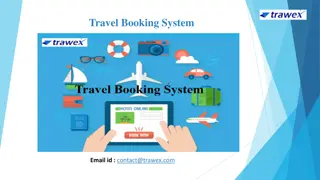Enhancing Travel Planning with Fiji's National Journey Planner (NJP)
Fiji is introducing the National Journey Planner (NJP) to help travelers efficiently plan their bus journeys for various purposes. The NJP will not only benefit tourists and locals but also support Fiji's Bus Operators Association by promoting bus usage. This innovative tool will integrate with the eTicketing platform to display fares and optimize routes, making it accessible on PCs, smartphones, and tablets without requiring registration. It will offer real-time bus information, including occupancy levels and proximity alerts, ultimately expanding to include multiple transport modes like ferries and flights, plus service alerts.
Download Presentation

Please find below an Image/Link to download the presentation.
The content on the website is provided AS IS for your information and personal use only. It may not be sold, licensed, or shared on other websites without obtaining consent from the author.If you encounter any issues during the download, it is possible that the publisher has removed the file from their server.
You are allowed to download the files provided on this website for personal or commercial use, subject to the condition that they are used lawfully. All files are the property of their respective owners.
The content on the website is provided AS IS for your information and personal use only. It may not be sold, licensed, or shared on other websites without obtaining consent from the author.
E N D
Presentation Transcript
National Journey Planner (NJP) Why Does Fiji Need a NJP? The NJP will assist travellers to plan their bus journeys for employment social, leisure and for the benefit of foreign tourists who may not know that there are alternatives to taxis in Fiji which provide an often more frequent and cheaper alternative. As well as being of significant benefit to travellers it will encourage greater use of buses and this will be welcomed by the Fiji Bus Operators Association. It will integrate with the current eTicketing platform and will facilitate the fares for all journeys (Adult, Child, Concession etc.) being shown when a journey is requested by the customer. The NJP will be optimised for use on a PC through the LTA website a smartphone and a tablet. There will not be a requirement to register for the NJP so that it is available to all and in particular to visitors to Fiji. 2
How Will the NJP Work & What Will It Show ? The screen shots used in this PowerPoint are for illustrative purposes only and designed to visually present what is possible. The traveller begins by opening up the app They will be asked whether they wish to begin their journey at the nearest bus stop to their location they can answer Yes or No. If they answer No they can input the commencement point of their journey or select from a drop-down menu of bus stop locations. Once a departure point is selected then a destination can be chosen. If the traveller wishes to depart immediately that option is included. If not The day and time of travel can also be selected. A select journey button is now pressed and the optimised route is calculated including bus transfers. 3
How it Works 2 The next 3 buses are displayed on the screen together with the operator s name in real time. The fare for the selected journey is also shown. A map pops up which shows the position of the bus as it approaches the boarding point of the selected journey. A series of pictograms displayed below each of the 3 journeys show how full the bus is at that moment in time. One block indicates 25% full; two blocks indicate 50% full; three blocks indicate 75% full and four blocks indicate the bus is full. In the event of a full bus the traveller has the option to wait for the following bus or decide to abandon the journey. Eventually the journey planner will become multi modal and will show ferries, flights, taxis and minibuses and will include the walking distance from the travellers start point to the bus stop. It is envisaged that service alerts will also become a feature of the journey planner advising travellers of delays due to unforeseen circumstances such as traffic congestion etc. A proximity alert can also be built into the journey planner to notify travellers on a bus when the bus is approaching their stop so that they can prepare to alight. 4
Fig 4 Shows the map with bus stops and the roads traversed on the route Fig 1 Shows from & to & the 3 service options Bus-Tram-Taxi journey time and Fare Fig 3 shows a combination of Bus and Rail to achieve the journey selected Fig 2 Shows the return journey with two options available 5
Fig 6 Shows a list of buses from a stop served by more than one bus route Fig 5 shows the map and an actual strip timetable 6
Fig 7 Typical eTicketing architecture on which the NJP would sit 8
Fig 8 Example of Drivers Roster which the LTA would be able to offer to Bus Operators 9
Introduction of Route Numbering It will be necessary for the LTA to number every bus route in Fiji for recognition purposes. By using a logical sequence of numbers as illustrated below it will be possible to improve recognition of bus routes for customers. Suva All route numbers will begin with a 1xx Nadi All route numbers will begin with a 2xx Lautoka All route numbers will begin with a 3xx Sigatoka All route numbers will begin with a 4xx Nausori All route numbers will begin with a 5xx RakiRaki All route numbers will begin with a 6xx Rural Services all route numbers will begin with 7xx Special Services all route numbers will begin with 8xx Inter Urban Express Services all route numbers will begin with 9xx Where there is common line of route by more than one bus company all bus companies on this route will utilise the same route numbering. This will make it easier for customers for recognition purposes. 10
Customer Benefits Will encourage increased ridership as the bus can be seen on the map approaching the customers bus stop. Loading information indicates to the customer that they may need to catch an earlier or later bus depending on their travel preferences. Planning customer journey s will become easier, enhancing confidence in the reliability of the bus network. Increased revenue for operators Formatted simplified timetables designed to fit on mobile devices and tablets. Bus Transfers will be more reliable and easier to understand. The overall perception in the customer s eyes of bus transport will be immeasurably improved. There will be shorter waits at run down bus shelters in the rain and heat of the Fiji climate particularly in rural areas where services tend to be low frequency. Will enable dynamic pricing of bus travel with higher fares in peak times contrasted with lower fares on evenings Sundays and off peak during the day. On Inter-Urban express services seat reservations will be possible helping operators deliver an improved service. As other modes become available later true transport integration will address the first and last mile conundrum. The "last-mile" or "first and last-mile" connection describes the beginning or end of an individual trip made by public transportation. A common example: a traveller reaches their local bus station, but after getting off the bus has no way to access the final destination. 11
Benefits to the Authority with the Introduction of the National Journey Planner. The technology behind the NJP revolves around the Authority having a scheduling system. This scheduling system will allow for the following Authority enhancements to be introduced: Real Time Tracking and identifying all bus services in Fiji Schedule v Actual Adherence for every bus service in Fiji will be used as a performance monitor. Operators who fail will be fined for non-operation. Provide for all RRL Licences to become electronic as opposed to bits of paper as the current system. Coordinate bus services where more than one company operates on the same route to create even headways along the route, thus providing customers with an improved service. Allow the LTA to eliminate wasteful duplication of bus services and redirect the resources to other more deserving routes. Monitor the effects of general traffic congestion on bus services and act in concert with other authorities to deal with reoccurring congestion. Consequent with the introduction of origin and destination (tap on tap off) it will be possible to determine patronage and vehicle loadings at any point along the route and act to apply sanctions on the operator to deal effectively with overloading of buses particularly in peak times. Introduction of TIN s for non-operation/late or early operation for reasons wholly within the operators direct control. This will become a large revenue earner for Government. 12
Benefits to the Authority with the Introduction of the National Journey Planner. (2) Will enable the LTA to provide customers with real time service updates through the app. Will facilitate development to include ferries, Taxis (using an UBER Style System) aircraft and LM minibuses. Provides for a clean road mapped route for every bus route in Fiji showing stops points of interest and desirable traffic objectives such as hospitals, schools university campus, shopping malls, airports, ferry jetties, tourist attractions etc. The LTA would offer vehicle and crew rostering facilities to bus companies for a commercial fee thus reducing their costs and generating revenue for the Authority as a contribution to its costs. 13
How would this project be delivered? Purchase or lease the Austrics scheduling system Commission a supplier to build the journey planner app and desktop version Purchase GIS maps for all of Fiji see below for a more detailed scope. Commission a Transport Specialist data management company to enter all the initial data into the schedules system and carry out a network optimisation which would feed bus economies without disadvantage to customers across Fiji. The subsequent updating of the bus timetables reflecting any changes sought by the bus companies or introduced by the LTA in efficiencies will be performed by trained LTA staff. Commission training of LTA staff in the operation of the scheduling system Introduce electronic RRL licences and service registration replacing the paper based system Employ temporary staff (12-month contract) to plot every bus stop in Fiji on the GIS mapping Recommend hosting on a cloud based server 14
Building the National Journey Planner App. The app will be built in four phases these are: Phase 1 initial development and integration with bus information and eTicketing system Phase 2 Ferry information integrated in the NJP Phase 3 Airline information integrated Phase 4 Taxis and minibus integration as well as on demand transport 15
Development Requirements Algorithms allowing users to calculate a route to their destination based on the bus schedules The ability for users to see what the price of their journey would be Real-time estimates of how close a bus is to its maximum passenger capacity Real-time data estimating how far away a bus is from the passenger s stop Walking directions to the stop where the passenger would need to board the bus Development of a native Android application with the above functionality Development of a native iOS application with the above functionality Development of a web based application with the above functionality 16
On-Going Support On-going Requirements To ensure the system continues to run effectively and provide a high quality and reliable user experience an on-going service support contract will be necessary. Iterative Development Process The initial phase of the application will all be around testing using a robust test plan as the application is a customer facing one and needs to be reliable from the outset. The integration with the existing eTicketing system will be a key component to ensuring the success of the application. 17
Questions? 18























